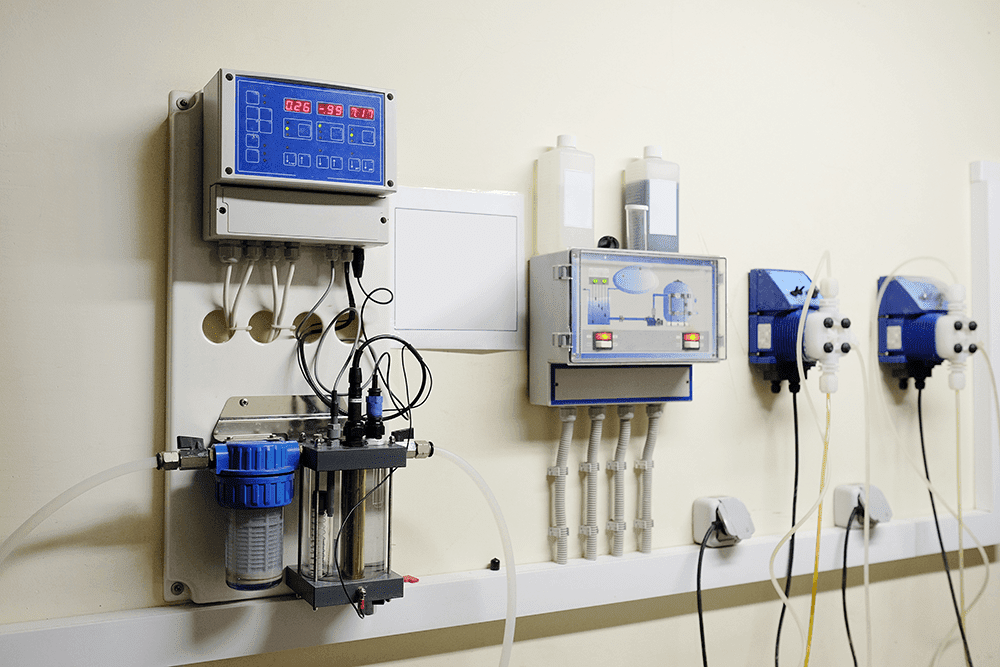04/13/2018 | pH | 4 MINUTE READ
How to Reduce pH Sensor Maintenance (Part 2)

Our last post discussed pH sensor cleaning and how flat surface pH glass can reduce your cleaning requirements. This week, we will explore a common pH sensor failure mode: pH sensor reference poisoning.
Some applications, like wet scrubbers and dye baths, can be extremely challenging to manage, as pH sensors are constantly returning erratic readings. One culprit is pH reference poisoning. Reference poisoning increases maintenance requirements and costs, since poisoned sensors may need to be replaced.
What is a pH sensor reference?
A combination pH sensor is the most common electrochemical pH sensor design. The design combines a hydrogen ion selective electrode (ISE) with a reference electrode that provides a stable electrical potential. Comparing the electrical potential from the H+ ISE to the electrical potential from the reference gives you a voltage, which corresponds to a pH value.
A pH sensor reference consists of reference electrolyte and a reference wire. The reference wire conducts the electrical potential of the stable reference electrolyte. Most Sensorex pH electrodes use silver/silver chloride (Ag/AgCl) reference wires. Silver is a good electrical conductor and a non-toxic material.
Different gels and solutions are commonly used as reference electrolyte. These solutions typically have some properties in common:
- Good electrical conductivity
- Does not react with solution being measured
- Positively and negatively charged ions diffuse at similar rates
Potassium Chloride (KCl) is an example of a common reference electrolyte.
What is reference poisoning?
A pH sensor reference must maintain electrical contact with the solution being measured to close the electrical circuit. Therefore, a porous junction separates the reference electrolyte from solution, allowing electrolyte outflow.
Over time, chemicals from the solution or process being measured may get past the reference junction. When these chemicals mix with the reference electrolyte, the chemistry of the reference is altered. This phenomenon is called reference poisoning.
In particular, ions that form salts with silver that are less soluble than silver chloride (AgCl) will impact reference stability. Examples include bromide (Br–), Iodide (I–) and sulfide (S2-) ions. Less soluble silver salts will precipitate out of solution, depleting the availability of silver ions. Similarly, reducing agents (like bisulfite) reduce silver ions to silver metal, and complexing agents (like ammonia) form metal complexes with silver ions. Both of these chemical reactions reduce the availability of silver ions in the reference system.
Eventually, when the silver chloride coating on the reference wire is totally depleted, large changes in reference potential may be observed. This is a sign that your sensor needs to be replaced.
Signs of reference poisoning
When sensor readings are erratic, we always recommend testing your pH sensor in a buffer solution with known pH. The key sign of reference poisoning is a large offset when measuring a buffer solution. Offset is the difference between the expected pH value (the pH value of the buffer: 4.0, 7.0, or 10) and the actual value. New sensors from the factory have an offset of 0.2 or less.
Signs of reference junction clogging
Reference system contamination can also lead to clogging of the porous reference junction. When silver salts precipitate out of reference electrolyte, the solid precipitate plugs up the pores in the reference junction. This interrupts the electrical connection between the reference and the process. Reference clogging also occurs when measuring solutions containing heavy metals (e.g. mercury, lead), because heavy metal ions form insoluble salts with chloride ions. Signs of a clogged junction include slow sensor response time and drifting pH values. Often, sensor performance is restored by cleaning the electrode per the guidelines in the product instruction manual.
How to prevent reference poisoning
Differential pH sensor technology
If reference poisoning is a problem in your process, you may consider using a differential pH sensor. Differential pH and ORP sensors contain buffered reference electrolyte, which resists changes in pH. This means that a differential sensor can actually withstand some contamination before the reference chemistry is altered significantly. Differential pH sensors from Sensorex also have refillable references, so the electrolyte solution can be replaced. The junction of a differential pH sensor is a replaceable salt bridge, which can be easily swapped out in the event of precipitate build up.
Double junctions and extended reference paths
When using combination pH sensors in challenging applications, look for sensors with a double junction reference design. As the name suggests, double junction sensors feature two porous junctions to protect the reference electrode from contamination. Some sensors also feature extended reference path (ERP) technology, which is a long and complex pathway that prevents foreign ions from reaching the reference wire.
Want more water quality monitoring tips? Subscribe to our blog and never miss a post!
Posted by Dominic O'Donnell on April 13, 2018
Sensorex is a global leader in the design and manufacture of quality sensors for water quality and process applications. The company offers more than 2000 sensor packages for pH, ORP, conductivity, dissolved oxygen, free chlorine, chlorine dioxide, UV transmittance and other specialty measurements, as well as a full line of sensor accessories and transmitters. Its expert technical support engineers solve analytical sensor challenges with custom designs and off the shelf products.




